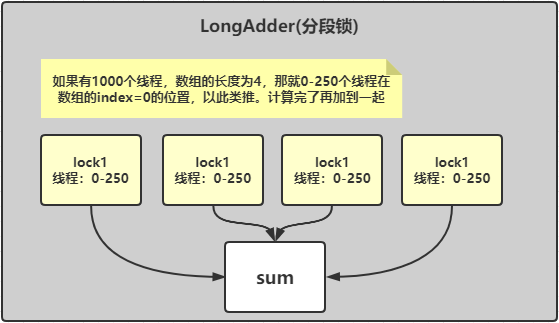Java Atomic类及线程同步新机制原理解析
AmourLee 人气:0本文着重讲解了Java Atomic类及线程同步新机制原理解析,文中通过代码实例讲解的非常细致,对大家的工作和学习具有一定的参考学习价值,欢迎大家阅读和收藏
一、为什么要使用Atomic类?
看一下下面这个小程序,模拟计数,创建10个线程,共同访问这个int count = 0 ;每个线程给count往上加10000,这个时候你需要加锁,如果不加锁会出现线程安全问题,但是使用AtomicInteger之后就不用再做加锁的操作了,因为AtomicInteger内部使用了CAS操作,直接无锁往上递增,有人会问问什么会出现无锁操作,答案只有一个:那就是快呗;
下面是AtomicInteger的使用方法:
package com.example.demo.threaddemo.juc_008;
import java.util.ArrayList;
import java.util.List;
import java.util.concurrent.atomic.AtomicInteger;
/**
* @author D-L
* @Classname T01_AtomicInteger
* @Version 1.0
* @Description 使用AtomicInteger类代替synchronized
* @Date 2020/7/22
*/
public class T01_AtomicInteger {
// int count = 0;
AtomicInteger count = new AtomicInteger(0);
public /**synchronized*/ void m(){
for (int i = 0; i < 10000; i++) {
// count++;
count.incrementAndGet();
}
}
public static void main(String[] args) {
T01_AtomicInteger t = new T01_AtomicInteger();
List<Thread> threads = new ArrayList<>();
for (int i = 0; i < 10; i++) {
threads.add(new Thread(t::m ,"Thread" + i));
}
threads.forEach(o -> o.start());
threads.forEach(o ->{
try {
o.join();
} catch (InterruptedException e) {
e.printStackTrace();
}
});
/* for (int i = 0; i < 10; i++) {
new Thread(t::m ,"Thread"+i).start();
}
try {
TimeUnit.SECONDS.sleep(3);
} catch (InterruptedException e) {
e.printStackTrace();
}*/
System.out.println(t.count);
}
}
二、Atomic类,synchronized、LongAdder的效率验证 及 分析
模拟多个线程对一个数进行递增,多线程对一个共享变量进行递增的方法大概有三种;验证一下它们的效率,这里做一些粗糙的测试,基本已经能说明问题,具体情况还要根据实际情况:
第一种:使用long count = 0; 加锁来实现;
第二种:使用AtomicLong类来实现;
第三种:使用LongAdder实现;
package com.example.demo.threaddemo.juc_008;
import java.util.concurrent.atomic.AtomicLong;
import java.util.concurrent.atomic.LongAdder;
/**
* @author D-L
* @Classname T02_AtomicVsSyncVsLongAdder
* @Version 1.0
* @Description 测试Atomic类 synchronized LongAdder效率
* @Date 2020/7/22
*/
public class T02_AtomicVsSyncVsLongAdder {
static AtomicLong count1 = new AtomicLong(0L);
static Long count2 = 0L;
static LongAdder count3 = new LongAdder();
public static void main(String[] args) throws InterruptedException {
Thread [] threads = new Thread[1000];
/*-----------------------------------Atomic类-----------------------------------*/
for (int i = 0; i < threads.length; i++) {
threads[i] = new Thread(() ->{
for (int j = 0; j < 100000; j++) {
count1.incrementAndGet();
}
});
}
long start = System.currentTimeMillis();
for (Thread t : threads) t.start();
for (Thread t : threads) t.join();
long end = System.currentTimeMillis();
System.out.println("Atomic:" + count1.get() +"-----time:" +(end - start));
/*----------------------------------synchronized---------------------------------*/
Object lock = new Object();
for (int i = 0; i < threads.length; i++) {
threads[i] = new Thread(new Runnable() {
@Override
public void run() {
for (int j = 0; j < 100000; j++) {
synchronized (lock) {
count2++;
}
}
}
});
}
long start2 = System.currentTimeMillis();
for (Thread t : threads) t.start();
for (Thread t : threads) t.join();
long end2 = System.currentTimeMillis();
System.out.println("synchronized:" + count1.get() +"-----time:" +(end2 - start2));
/*-------------------------------------LongAdder----------------------------------*/
for (int i = 0; i < threads.length; i++) {
threads[i] = new Thread(() ->{
for (int j = 0; j < 100000; j++) {
count3.increment();
}
});
}
long start3 = System.currentTimeMillis();
for (Thread t : threads) t.start();
for (Thread t : threads) t.join();
long end3 = System.currentTimeMillis();
System.out.println("LongAdder:" + count1.get() +"-----time:" +(end3 - start3));
}
}
/*----------------------------------运行结果---------------------------------*/
Atomic:100000000-----time:2096synchronized:100000000-----time:5765LongAdder:100000000-----time:515
从以上的结果来看并发量达到一定程度运行效率:LongAdder > AtomicLong > synchronized; 这个还只是一个粗略的测试,具体使用还要根据实际情况。
为什么AtomicLong的效率比synchronized的效率高?
AtomicLong的底层使用的是CAS操作(无锁优化),而synchronized虽然底层做了优化但是并发量达到一定层度,存在锁的膨胀,最终会变成重量级锁,需要向操作系统申请锁资源,所以synchronized的效率慢一点合情合理。
为什么LongAdder的效率比AtomicLong的效率高?
因为LongAdder使用了分段锁的概念,效率比AtomicLong的效率高。

分段锁的意思就是用一个数组把线程分成若干组,然后运行结束后把结果累加起来,例如你有1000个线程,数组的长度为4,那就把0-250个放到数组的第0位,以此类推,然后把四个数组中线程的计算结果累加,这样会很大程度上节省时间,从而提高效率。
加载全部内容